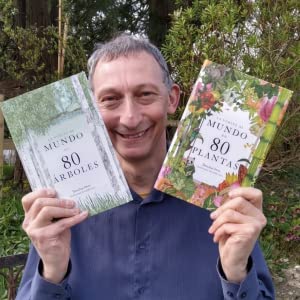In Jonathan Drori’s book, Around the World in 80 Plants, we’re swept away to different ends of the globe as we learn about the rich, surprising history of plants. Drori takes us from the East Mediterranean and South East Asia to the Americas and everything in between. With quick wit and gorgeous prose, even the unlikeliest of plants become interesting to us.
What first drew me to this book were the illustrations by Lucille Clerc. With a panda gnawing on bamboo, and Ganesh, the Hindu God of removing obstacles, nestled by marigolds on the front cover, I was immediately attracted to the book. It doesn’t hurt that when I cracked it open, I was led to a full-page spread of beautiful pink-purple blooms, with a just-as-pink Buddha sitting cross-legged on a lily pad. This aligns well with my belief that books for adults shouldn’t be devoid of illustrations; illustrations entice us and fill us with joy in a way that writing alone may not always provide. It’s like ripe mangoes and red chili pepper — sometimes, it’s just better when they’re together.
I was most drawn to the section on Central and South America. This is where our author speaks about the splendor of Iranian damask roses, which, in illustration, seem to have blooms as big as the palms of my hands; the crushing of the Henna leaves, which leads to the adornment of hands and feet in Pakistani and Indian wedding ceremonies alike; the niftiness and sacredness of lotus flowers, with blooms that lure beetles in to trap them inside to pollinate for the night before they’re released in the day (and the fact that the leaves are so waterproof that scientists attempt to recreate “the lotus effect” to make rainwear–how cool); and the history of the mango, which was forcefully fed to cattle in order to create a vibrant Indian Yellow pigment for painting from their urine. Don’t fret, however, this practice was outlawed in the twentieth century.
My family is from India, where mangoes are present galore in the hot season, and they’re beloved by many. I wanted to share some of the interesting things I learned with my family. Sitting by my mom, I went paragraph by paragraph, translating as needed. She turned to my father, who worked on a family farm when he was young. "Did you know that mango trees will have a lot of fruit one year, and then not quiet as much the next year?" My dad explains how the crop yields grow to my mom, sharing some of his childhood knowledge with her. This is a small moment that occurred, but even so, a page in this book offered my family and I some connection.
Around the World in 80 Plants is actually a companion piece to Drori’s first book, Around the World in 80 Trees. This book was a huge success and was also illustrated by Lucille Clerc. As stated on his website, Drori “wanted to inspire readers with a love for trees[,] but also a wish to protect them and their habitats, alongside an appreciation of the crazy things they get up to.” If you’re writing about 80 plants and 80 trees, I’m certain that you have to be pretty passionate about the environment. And Drori is a passionate environmentalist. He’s donated some of his proceeds from his first book to Kew, the WWF and The Woodland Trust. Along with this, he’s on the board, is an ambassador, or is a member of many environmental organizations like Eden Project, or the WWF.
What I enjoy the most about this book is that you would imagine that a book on plants could be really dry, but no! Read some clever, luscious, humorous excerpts with me.
When scientists find out they really did force feed cattle mangoes for yellow pigment, Drori writes: “The legend was more than just a pigment of imagination.”
Or, in terms of the damask rose: “While the flavour of rose desserts teeters between transcendent bliss and the sensation of eating soap, surely the world needs more of the love that roses signify."
He puts a bit of his own opinion in the writing in a lighthearted way, like when he’s speaking about Artichoke: “Obviously, they taste best when their hearts are grilled with a hint of orange, but, steamed whole and accompanied by lashings of melted butter from a communal dish, the dipped bracts make a sociable and engagingly messy treat.”
Drori almost always ends each section on a plant with beautiful imagery. Take the ending of the section on lotus flowers: “The lotus, perfect and unsullied by the muddy waters in which it grows, with glittering beards of water that dance and sparkle, jewel-like, in the centre of its leaves, symbolizes the spiritual journey towards light and wisdom.”
Jonathan Drori’s work is certainly not a book you can finish in one sitting. Instead, it’s a book to keep with you through your travels and adventures, flipping through its pages on front porch steps when the sun is setting, or on a bus as the night falls, or early in the morning when birds are chirping. When you read this book, you’ll see the world through his eyes - a place of beauty, a space to be honored, cherished, protected, and loved.
For more information about Jonathan’s work, visit his website at Jonathan Drori – Environment, Technology, Education, Books (jondrori.co.uk).
-Anita Patel is a Youth Services Assistant at the Lawrence Public Library who enjoys childrens’ books, nature, and little things that bring joy like good friendships.





Add a comment to: Around the World in 80 Plants – An Adventure with Jonathan Drori